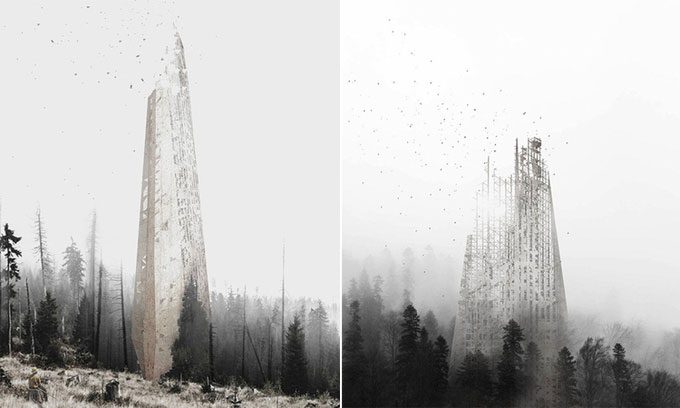Italian architect proposes a large structure made of earth, seeds, and nutrients to be placed in a forest ravaged by fire.
Italian architect Alberto Roncelli has proposed the idea of a self-decomposing “skyscraper” called Regenera, designed to naturally disperse nutrients and seeds in forests that have been devastated by fire, reported Mail on June 28. Regenera is not an actual building but is referred to as such due to its large size.

Design of Regenera – a structure made from earth, seeds, and nutrients. (Photo: Alberto Roncelli).
Regenera is built from earth, seeds, and nutrients. It will be situated in the center of an ecosystem that has experienced wildfires. In the initial phase, scientists will monitor the recovery of the ecosystem from a laboratory on the ground. Eventually, as Regenera gradually decomposes due to wind effects and becomes rubble, researchers will leave it as a shelter for birds and small animals.
Roncelli stated that to make his design truly effective, he would need to collaborate with chemists, biologists, meteorologists, and farmers to determine the quantity and diversity of nutrients, the erosion timeline, and how each “building” reacts to wind. He describes Regenera as a “manifesto” for a new approach that connects architecture with nature, structures with ecosystems, time with erosion, and skyscrapers with forests.
Last summer, over 20 major wildfires raged in California, USA. Among them, the August Complex fire, which began on August 17, 2020, is considered the largest fire in the state’s history. By September 10, 2020, over 190,600 hectares of land surrounding Tehama County had been devastated.
In Australia, the 2019-2020 wildfire season was so severe that it was dubbed the “Black Summer.” The fires peaked in December 2019 and January 2020. By March, approximately 18.6 million hectares of forest in New South Wales, Victoria, and the Australian Capital Territory were affected, resulting in at least 36 fatalities and the deaths of hundreds of millions of reptiles, marsupials, and other creatures. NASA estimated that wildfires in Australia emitted around 337 million tons of CO2.
Wildfires have become more severe in recent years due to drought and rising temperatures—a consequence of climate change. One of the most concerning issues is the rapid spread of wildfires, leaving authorities with little time to warn and evacuate residents.
“Natural fires can benefit native plants, animals, and ecosystems that thrive due to wildfires. But in recent decades, we are facing increasingly larger wildfire disasters caused by humans. In the case of large and severe wildfires, ecosystems can be completely destroyed, some even unable to recover,” Roncelli stated.



















































